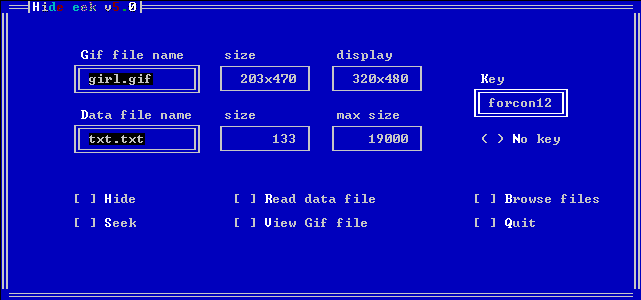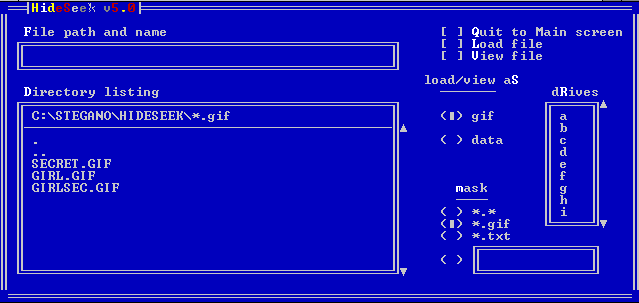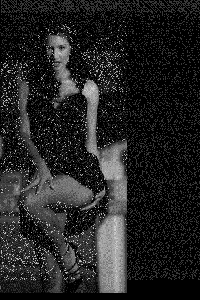Hide and Seek v5.0
Hide and Seek ist kein Programm zum Verschlüsseln von Daten. Es dient lediglich dazu, einen ASCII-Text in einer Binärdatei -einer Grafik im (Compuserve-)GIF-Format - zu verbergen. Der Text kann verschlüselt worden sein - mit PGP zum Beispiel - oder nicht. S-Tools ist also nur ein spezieller digitaler und unverdächtiger Briefumschlag.
Wenn sie normalerweise ihre E-Mail verschlüsseln, ist die Tatsache der Kodierung selbst nicht verborgen. Das ist weder verboten noch verdächtig. Aber wäre es nicht besser, sie würden diesen hübschen Umschlag benutzen, dass alle denken, es handele sich um normale Post, die rein gar nichts Unübliches enthält?
Wie benutze ich Hide and Seek?
- Hide and Seek - Download d. Versionen 4.1, 5.0 und 1.0 für Win95
- Kopieren sie die Datei hdsk50.zip (199 KB) in das Verzeichnis, das ihre steganographischen Programme enthalten soll. Entpacken sie es, entweder mit einem Zip-Programm für Windows oder mit dem DOS-Befehl pkunzip hdsk50.zip
- Schreiben sie mit einem beliebigen Text-Editor einen Text, zum Üben etwa 5-10 KB gross, und speichern sie ihn als MS-DOS bzw. ASCII-Text ab. Sie können den Text anschliessend mit PGP verschlüsseln oder ihn im Klartext belassen. (Hinweis: Hide and Seek behandelt Files wie text.asc, text.pgp oder auch text.txt völlig gleich)
- Wenn sie den DOS-Befehl hideseek eingeben, erscheint ein Menü:

- Tragen sie unter Gif file name den Namen der Grafik ein, in der sie den Text verbergen wollen. Sie können mit der Option browse files ihre Festplatte durchsuchen. Wenn sie - wie in diesem Beispiel - girl.gif eingetippt haben, drücken sie die ENTER-Taste. Hide and Seek zeigt ihnen dann automatisch die Dateigrösse an.
- Unter Data file name tragen die den Namen des Textes ein, den sie in die Grafik einbauen wollen. Wenn sie dann die ENTER-Taste drücken, rechnet Hide and Seek aus, wie gross der Textfile sein darf. (Warum, erklärt ihnen die unten abgedruckte englische Original-Anleitung). Dann geben sie noch ein Passwort ein - oder nicht.
- Dann werden sie gefragt, wie der Dateiname der Grafik heissen soll, die Hide und Seek erzeugt. Suchen sie sich einen beliebigen aus!
- Unter der Option browse files finden sie noch ein Menü, mit dem sie Dateien auswählen und sich ansehen können:

- Um einen Text aus einer Grafik herauszuziehen, wählen sie im Hauptmenü nur die Option seek statt hide.
Hide and Seek gibt zwar eine Maximalgrösse für den eingebauten Text an, in der Realität ruiniert jedoch ein schon wesentlich kleinerer Text das Originalbild. Aber darauf kommt es ja nicht unbedingt an: Steganographie verbirgt nur auf den ersten Blick, dass es sich bei der E-Mail nicht um eine Binärdatei, sondern um einen Text mit einem Binär-"Umschlag" :-) handelt. Hier ein Beispiel: links sehen sie die Originaldatei girl.gif (36040 Bytes, hier nicht die Originalgrösse!). Rechts ist die gesamte Hide and Seek-Anleitung ( siehe unten) - 9897 Bytes - eingebaut worden. Das Bild ist etwas verändert worden, obwohl Hide and Seek sogar die doppelte Dateigrösse erlaubt hätte. Bei bunten Grafiken oder Bildern jedoch funktioniert Hide and Seek so schlecht, dass das sogar Computer-Laien auffällt! :-)


HideSeek v5.0 - Anleitung im Original
"Welcome to HideSeek v5.0. This is a radical update to hideseek v4.1
which includes a lot of new features. First, there is an interface....no more command line. In fact, you can no longer run hideseek from the command line at all. Second, and more importantly, hideseek now works with a lot more display resolutions that 320X480. Hopefully, this will make it a lot more usefull...
To run hideseek, just type "hideseek" at the c> prompt and away
you go. hideseek is a dos program. i don't know what will happen if you try to run it under windows--i never have.
Once in hideseek, you are presented with the main screen. You may use the mouse (if you have one) to click in any double-bordered box or on any button, or just type a highlighted letter to select an option. The options are:
- Gif file: select the gif file to use for both hiding and
seeking data. If you are hiding, you will eventually be asked for a name for the output gif file. Greyscale GIFs work best for hiding.
- Data file: select the data file. This file will either be hidden, if you choose to hide data, or will
be the name of the output file if you are seeking data. Note that it must be empty if it is to be an output file.
- Key: input a key to lock data in the file. This key
encrypts the header hideseek uses with the
IDEA algorithm, although it does not encrypt
the data at all. This function is usefull if you want to make it hard for people to
get your data out....no key, no seek. to use NO KEY click the No Key radio button.
this will clear the key for you. if this button is not selected you are using a key
wether you see one or not!!! it will also say "(none)" in the key box if you are not
using a key (or if your key is "(none)"--- you know who you are).
notice that the key box will blink after you hide data, to remind you of having used
a key. you can get rid of this blinking by pressing No Key or entering a new key.
- No Key : clears the key and the key input box. this is a
radio button and will automatically clear
if you enter a key....if the button is not
selected, you have a key. see above.
- Browse : takes you to a file browsing screen documented later.
- View : shows you the gif file you have selected.
- Read : shows you the data file you have selected.
- Quit : quits the program.
- Hide : hides the data file in the gif file. asks for name for an output gif file.
- Seek : looks for data in the gif file and writes it to the data file....the data file must be empty.
The browse screen has a bunch of functions for looking through your
directories for files:
- The File box lets you enter a file path and name. You can use it to
change disk and directory and select a file mask or select a file.
- the Directory box lets you look through your direcory tree. You may
press ESCAPE to leave the box without making a choice.
- the drive box lets you change drives.
- the mask buttons let you select a file mask, which will affect what the directory display shows.
- the "load/view as" selector lets you decide to load or view a given
file as a Gif or a Data file.
- the View button shows you the file you have selected. the button
is sensitive to the load/view As button
- the Load button loads the file and returns you to the main screen
- the Quit button returns you to the main screen without loading any
file.
That's it! error messages should be pretty self-explanatory. One thing to
watch out for: if it tells you it cannot display your gif file, it is because
hideseek does not support your video card at the required resolution. It may
suggest that you resize the gif (using a separate program) and try again.
if there is data hidden in the file Do not resize it!!!! the data would be
lost.
HideSeek can be pretty slow for large gif and/or data files. Please be
patient. I apologize for the slowness.
HideSeek will make an output gif (if you are hiding) that matches the DISPLAY
size, not the original GIF size. annoying, but that's life (more specifically
that's the fastgraph graphics toolbox.) note that because of this the WHOLE
display including the black area around your gif gets used in the hiding
process and IS a part of the new gif....Do not resize!!!!
Steganography works, in this case, by making subtle, reversible alterations
in the gif file. Basically, it takes the low-order bit of each pixel and
uses it to encode 1 bit of a character. Thus, 8 pixels can encode 1
character. This creates noticeable "noise" in the picture unless you use a greyscale gif, in which case there is no noise, due to the way the greyscale palette works. Carefull analysis of a gif migth be able to detect
that there is hidden data, but it may not. depends on the gif.
For Hideseek to be really usefull, you must use greyscale GIFs. Color gifs are just too obvious.
HideSeek tries to be more secure by using a pseudo-random number generator
to "disperse" the data throughout the GIF....thus, not all pixels contain
data. It is impossible to tell which pixels do contain data, thus rendering
hidden data very secure. HideSeek needs to remember the file size and the
seed for the PRNG in order to carry this out succesfully. Thus, it writes
a header to the GIF file first thing. Since this is not being very sneaky,
it encodes the header, using the IDEA algorithm, and a key you supply, or
can supply, if you want to. This makes the data very hard to extract. there
are literally billions of possible files in any given GIF, and millions of
possible keys to try and guess. Actually, there are only 32,000 possible
seeds to try and guess, making that the weak link in the chain. But, without
the key you don't know the file length, and if someone were so sneaky and
devious as to hide encrypted data, well, there's no telling whether what
you pull out is just junk or a real secret file. I have included IDEA.EXE,
a simple encryption program for use in doing just this. It is not the
best possible program, but it is adequate. See the idea.doc file for more
info.
Test your program on secret.gif. secret.gif has a copy of idea.zip, a
simple encryption program, hidden in it using no key. if you can get out
a .zip file that unzips to an encryption program, all is well.
Hideseek 5.0 is completely backwards compatible with HideSeek 3.5 and later.
files hidden with these earlier version can be extracted with this version,
but not, of course, vice versa.
hideseek is freeware. have a nice day.
The IDEA(tm) conventional block cipher used by HIDESEEK and IDEA is
covered by a patent in Europe, held by ETH and a Swiss company called
Ascom-Tech AG. The patent number is PCT/CH91/00117. International
patents are pending. IDEA(tm) is a trademark of Ascom-Tech AG. There
is no license fee required for noncommercial use of IDEA.
You may not extract the IDEA cipher from HIDESEEK or IDEA.EXE and put it
in another commercial product without a license. Commercial users of
IDEA may obtain licensing details from Dieter Profos, Ascom Tech AG,
Solothurn Lab, Postfach 151, 4502 Solothurn, Switzerland, Tel +41 65
242885, Fax +41 65 235761.
The GIF format is copyrighted by compuserve.
HIDESEEK and IDEA are freeware and I am an amateur. they are tested as
well as I have been able to test them, are as safe as i can make them,
and I am confident that they are robust. Nevertheless, you may only use
them at your own risk. I cannot and will not be responsible for lost
data.
-----Remember: when cryptography is illegal, only 9*7^Py.> *8D7awQs û×9Ikj;"
HTML-Auszeichnung: B.Schröder©






